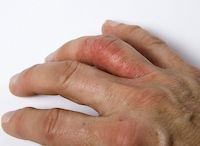Tofacitinib Improves Quality of Life, Skin Symptoms In Psoriatic Arthritis
A post hoc analysis of the OPAL Beyond and OPAL Broaden studies found tofacitinib improved skin-related symptoms and health-related quality of life in psoriatic arthritis patients with an inadequate response to csDMARDs or TNFi treatment.

In addition to a study examining the median time to pain improvement with tofacitinib in patients with psoriatic arthritis, an additional study examining signs, symptoms, and health-related quality of life of patients receiving the treatment was presented at the Clinical Congress of Rheumatology (CCR) West 2019 annual meeting in San Diego, CA.
Results of the post hoc analysis revealed tofacitinib therapy improved skin-related dermatological signs and symptoms and health-related quality of life in psoriatic arthritis patients with an inadequate response to conventional synthetic disease-modifying antirheumatic drugs (csDMARDs) or non-tumor necrosis factor inhibitor (TNFi) at 3 months when compared with placebo.
Led by Joseph Merola, MD, of Brigham and Women’s Hospital, investigators conducted an analysis of the use of the oral JAK inhibitor in patients from the OPAL Beyond and OPAL Broaden trials to determine tofacitinib’s efficacy for dermatologic domains in patients with psoriatic arthritis.
Patients included in the study had active psoriatic arthritis and an inadequate response to 1 or more csDMARDs who were TNFi-naive or who had or who had an inadequate response to 1 or more TNFi. A cohort of 422 patients was derived from OPAL Broaden and 394 were identified from OPAL Beyond.
In both trials, patients were randomized to receive either tofacitinib 5 mg twice-daily, 10 mg twice-daily, or placebo therapy. In OPAL Broaden, adalimumab 40 mg subcutaneous once every 2 weeks was included as an active comparator. Patients randomized to placebo were changed to tofacitinib at month 3.
Additionally, patients must have had active plaque psoriasis at screening—defined as a diagnoses or confirmation from a dermatologist/rheumatologist. Investigators noted no minimum affected body surface area (BSA) was required for inclusion.
Endpoints points of the analysis included 75% or more and 90% or more improvement from baseline in Psoriasis Area and Severity Index, the proportion of patients achieving Physician’s Global Assessment of Psoriasis (PGA-PsO) of ‘clear’ or ‘almost clear’, and an improvement of 2 or greater from baseline among patients with baseline PGA-PsO of 2 or greater).
Other endpoints of the study included change from baseline in target fingernail Nail Psoriasis Severity Index (NAPSI), patients with baseline NAPSI greater than 0, Itch Severity Item (ISI) among patients with baseline ISI greater than 0) and Dermatology Life Quality Index (DLQI). Investigators noted nominal p values are used without adjustment for multiple comparisons.
Upon analyses, investigators found 73.9% of patients in OPAL Broaden and 62.7% in OPAL Beyond had 3% or more affected BSA, mean PASI score among patients with BSA of 3% or more and PASI greater than 0 was 9.2 and 10.7 and mean DLQI score was 8.8 in both groups. At month 3, more patients receiving either dose of tofacitinib achieved PGA-PsO response than patients receiving placebo therapy.
Additionally, greater improvements were observed in both studies with tofacitinib compared with placebo in regard to baseline ISI and DLQI. Differences in baseline NAPSI between tofacitinib or adalimumab and placebo did not achieve nominal significance in both studies examined. Similar effects were observed with adalimumab compared with placebo in OPAL Broaden across these endpoints.
This study, “Tofacitinib in psoriatic arthritis patients: skin signs and symptoms and health-related quality of life from two Phase 3 studies,” was presented at CCR West.